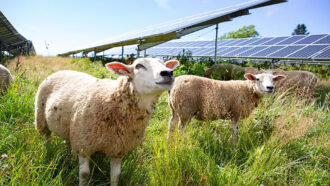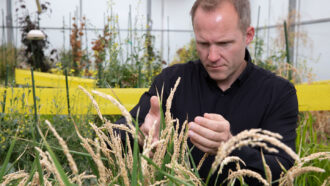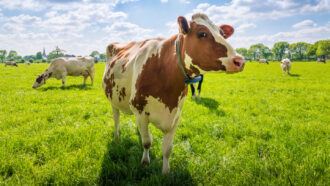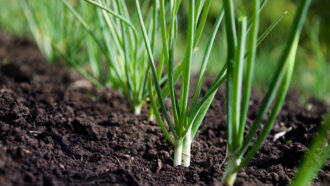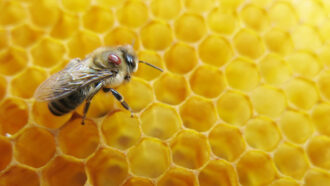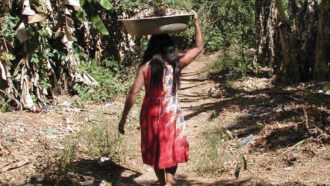New ‘tattoo’ could lead to drought-tolerant crops
A sensor made from graphene measures how fast plants slurp up water from the soil
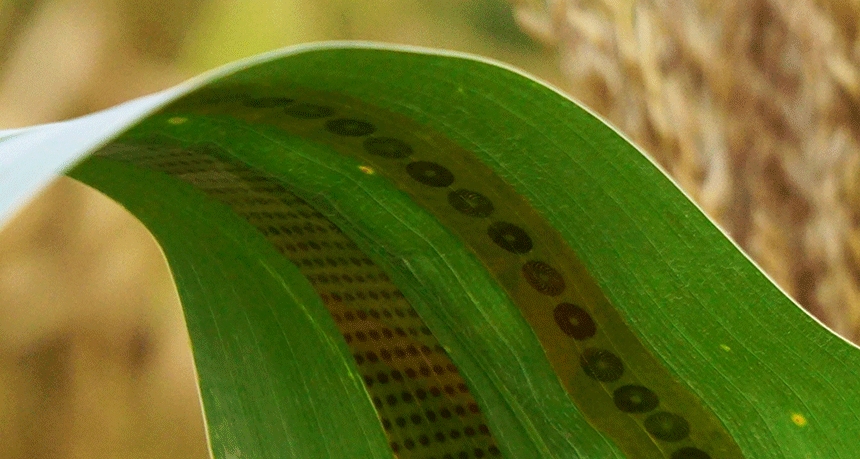
This corn leaf sports a “plant tattoo” made from patterned graphene on tape. Graphene is a single-atom-thick sheet of carbon that is great at conducting electricity. Measuring changes in the electrical current can tell scientists how fast a plant soaks up water.
Liang Dong/Iowa State University
Scientists have created a stick-on, tape-based sensor for plant leaves. It measures how much water a plant drinks up from the soil. With this information, plant breeders will know which individuals to choose as parent stock for crops that can survive droughts by making the most of the available water. That’s important because as Earth’s climate warms, periods of severe drought are expected to become more common.
Liang Dong led the team that developed the new sensor. He works at Iowa State University in Ames. As an electrical engineer, he designs, builds and analyzes electrical systems to meet particular needs.
Dong calls his sensor a “plant tattoo.” It is a piece of clear tape embedded with a tattoo-like design made from multiple layers of graphene flakes. Graphene is a sheet of carbon that is only a single atom thick. It not only is great at conducting electricity, but also mechanically strong, which means it won’t easily break apart.
When carbon bonds with itself to form graphene, each layer is so thin that you can’t even see it. The tattoo’s pattern is visible because it has been made from several layers.
For the tattoos, it was important that the graphene be laid down in a pattern instead of as a uniform sheet. Certain patterns conduct electricity better than others. Dong used mathematical formulas to figure out which patterns should work best.
When taped to a plant’s leaf, the tattoo can be attached to small wires. These connect to a battery and a device that can measure an electrical current. The battery sends a current through the graphene. That current will change depending on how fast water moves up the plant. This will reveal how quickly the plant drinks in moisture from the soil.
Dong and his team described their sensors in the December 2017 issue of Advanced Materials Technologies.
How they did it
The first step in creating the new tattoo was to make a mold from a plastic block. “We made indents and channels in the block and then poured a graphene solution on it,” explains Dong.
Once the graphene dried into flakes, Dong used tape to remove the excess from the block’s surface. He then applied a second piece of tape and pressed down on it firmly. When he pulled it up again, the graphene was now stuck to the tape.
Dong and his team experimented with different compounds created using graphene They settled on one called graphene-oxide. It’s a compound of carbon and oxygen that is very sensitive to moisture. When it comes in contact with water vapor, the speed at which a charge, or electrical current, moves through the graphene-oxide slows.
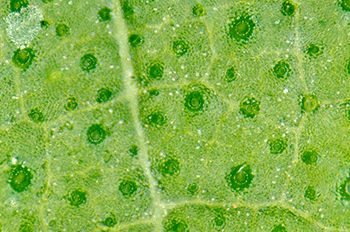
This is a useful trait. As plants take up water from the soil, water vapor escapes from tiny holes in their leaves called stomata. By measuring how much the electrical current slows after the sensor is stuck to a plant’s leaf, researchers can figure out how fast the plant is slurping up water.
The researchers tried out the plant sensor with corn plants. They measured how long it took for two varieties of corn plants to move water from their roots to their lower leaves, and then to their upper leaves. For one plant, it took 80 minutes, on average, to move water from its fourth to its ninth leaf. The other plant did this in only 28 minutes.
Elizabeth Lee is a plant scientist in Canada at the University of Guelph, in Ontario. This corn expert says some varieties of corn close their leaves’ stomata faster than others when the soil is dry. This helps them conserve water and better survive drought.
The new sensor is “a nice way to easily identify which varieties are better are conserving water,” observes Lee. Breeders might want to focus on these when developing drought-tolerant cultivars.
Dong says the next step in his research is to use the sensor to see how a crop’s use of water affects how many ears of corn are produced and how big they are.
“The ultimate goal of our work is to develop drought-tolerant crops that can deal with climate change,” he says.
